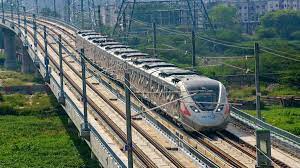All You Need To Know About PM Modi’s Inauguration Of The Delhi-Ghaziabad-Meerut RRTS
The first Namo Bharat train was launched off by Prime Minister Narendra Modi on a 17-km section of the Delhi-Meerut Regional Rapid Transit System (RRTS) on Friday.
He said that comparable services will soon connect a number of locations in Rajasthan, Haryana, and Uttar Pradesh.
Speaking at a gathering in Uttar Pradesh, Modi predicted that the whole 82-km section of the Delhi-Ghaziabad-Meerut RRTS would be finished within the next 1.5 years, and he expressed confidence that he will be there to officially open it.
“I lay the cornerstone for the Delhi-Ghaziabad-Meerut regional corridor project four years ago. Namo Bharat train services have begun today on the section between Sahibabad and Duhai Depot. The prime minister said, “We inaugurate the projects which we start. I had said that previously as well, and I reiterate it now.
“I will be there at your service when this Delhi-Meerut stretch is completed after a year or a year and a half,” Modi said.
Referring to the Delhi-Ghaziabad-Meerut RRTS route
The enormous RRTS project was created with the goal of revolutionizing regional connections in the nation by introducing brand-new, top-notch transportation infrastructure.
A rail-based, semi-high-speed, high-frequency commuter transport system that can travel at a speed of 180 kmph is known as the RRTS.
The project is being built at a cost of more than Rs 30,000 crore, and it is anticipated to cut the travel time between Delhi and Meerut to under an hour. The cities of Ghaziabad, Muradnagar, and Modinagar would be on the route.
The RRTS is a “transformational” regional development effort, according to a formal statement released by the PMO. It is intended to deliver high-speed trains for interstate travel every 15 minutes, with the ability to increase this frequency to every five minutes depending on demand, it stated.
The PMO observed that a total of eight RRTS routes have been selected for development in the National Capital Region, out of which three corridors—Delhi-Ghaziabad-Meerut, Delhi-Gurugram-SNB-Alwar, and Delhi-Panipat—have been prioritized for implementation in Phase-I.
What is feasible?
The nation’s intercity commuting options should be safe, dependable, and contemporary thanks to the high-speed, cutting-edge transportation infrastructure.
The RRTS network will include substantial multi-modal integration with railway stations, metro stations, and bus services in accordance with the PM GatiShakti National Master Plan.
“Such transformative regional mobility solutions will boost economic activity in the region, provide improved access to employment, education and healthcare opportunities; and help in significant reduction of vehicular congestion and air pollution,” stated the report.







